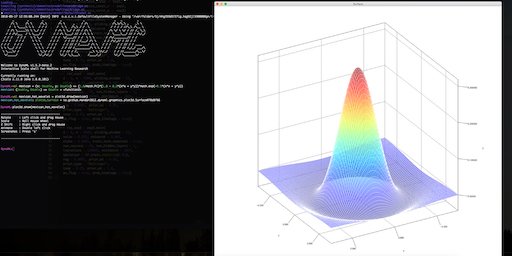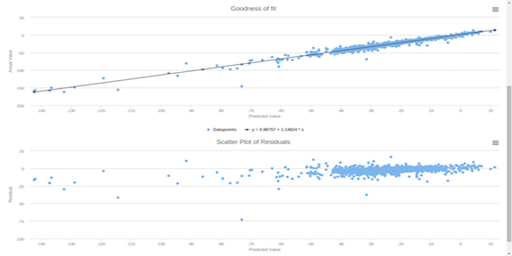tailhq / Dynaml
Programming Languages
Labels
Projects that are alternatives of or similar to Dynaml
DynaML: ML + JVM + Scala
DynaML is a Scala & JVM Machine Learning toolbox for research, education & industry.
 |
 |
|---|
Motivation
-
Interactive. Don't want to create Maven/sbt project skeletons every time you want to try out ideas? Create and execute scala worksheets in the DynaML shell. DynaML comes packaged with a customized version of the Ammonite REPL, with auto-complete, file operations and scripting capabilities.
-
End to End. Create complex pre-processing pipelines with the data pipes API, train models (deep nets, gaussian processes, linear models and more), optimize over hyper-parameters, evaluate model predictions and visualise results.
-
Enterprise Friendly. Take advantage of the JVM and Scala ecosystem, use Apache Spark to write scalable data analysis jobs, Tensorflow for deep learning, all in the same toolbox.
Getting Started
Platform Compatibility
Currently, only *nix and OSX platforms are supported.
DynaML is compatible with Scala 2.12
Installation
Easiest way to install DynaML is cloning & compiling from the github repository. Please take a look at the installation instructions in the user guide, to make sure that you have the pre-requisites and to configure your installation.
CIFAR in under 200 lines
Below is a sample script where we train a neural network of stacked Inception cells on the CIFAR-10 image classification task.
{
import _root_.ammonite.ops._
import _root_.io.github.tailhq.dynaml.pipes.DataPipe
import _root_.io.github.tailhq.dynaml.tensorflow.{
dtflearn,
dtfutils,
dtfdata,
dtfpipe
}
import _root_.org.platanios.tensorflow.api._
import _root_.org.platanios.tensorflow.api.learn.layers.Activation
import _root_.org.platanios.tensorflow.data.image.CIFARLoader
import _root_.java.nio.file.Paths
val tempdir = home / "tmp"
val dataSet =
CIFARLoader.load(Paths.get(tempdir.toString()), CIFARLoader.CIFAR_10)
val dtf_cifar_data = dtfdata.tf_dataset(
dtfdata.supervised_dataset(
dataSet.trainImages.unstack(axis = 0),
dataSet.trainLabels.castTo[Long].unstack(axis = -1)
),
dtfdata.supervised_dataset(
dataSet.testImages.unstack(axis = 0),
dataSet.testLabels.castTo[Long].unstack(axis = -1)
)
)
println("Building the model.")
val relu_act =
DataPipe[String, Activation[Float]]((x: String) => tf.learn.ReLU[Float](x))
val architecture =
tf.learn.Cast[UByte, Float]("Input/Cast") >>
dtflearn.inception_unit[Float](channels = 3, Seq.fill(4)(10), relu_act)(
layer_index = 1
) >>
dtflearn.inception_unit[Float](channels = 40, Seq.fill(4)(5), relu_act)(
layer_index = 2
) >>
tf.learn.Flatten[Float]("Layer_3/Flatten") >>
dtflearn.feedforward[Float](256)(id = 4) >>
tf.learn.ReLU[Float]("Layer_4/ReLU", 0.1f) >>
dtflearn.feedforward[Float](10)(id = 5)
val loss = tf.learn.SparseSoftmaxCrossEntropy[Float, Long, Float](
"Loss/CrossEntropy"
) >>
tf.learn.Mean("Loss/Mean") >>
tf.learn.ScalarSummary("Loss/Summary", "Loss")
val optimizer = tf.train.Adam(0.1f)
val cifar_model =
dtflearn.model[
Output[UByte], Output[Long], Output[Float], Float,
Tensor[UByte], UINT8, Shape,
Tensor[Long], INT64, Shape,
Tensor[Float], FLOAT32, Shape](
architecture,
(UINT8, dataSet.trainImages.shape(1 ::)),
(INT64, Shape()),
loss
)
val data_ops = dtflearn.model.data_ops[(Output[UByte], Output[Long])](
shuffleBuffer = 5000,
batchSize = 128,
prefetchSize = 10
)
val train_config = dtflearn.model.trainConfig(
tempdir / "cifar_summaries",
data_ops,
optimizer,
dtflearn.rel_loss_change_stop(0.05, 500),
Some(
dtflearn.model._train_hooks(
tempdir / "cifar_summaries",
stepRateFreq = 100,
summarySaveFreq = 100,
checkPointFreq = 100
)
)
)
val pattern_to_tensor =
DataPipe[Seq[(Tensor[UByte], Tensor[Long])], (Tensor[UByte], Tensor[Long])](
ds => {
val (xs, ys) = ds.unzip
(
dtfpipe.EagerStack[UByte](axis = 0).run(xs),
dtfpipe.EagerStack[Long](axis = 0).run(ys)
)
}
)
val data_handle_ops = dtflearn.model.tf_data_handle_ops[
(Tensor[UByte], Tensor[Long]),
(Tensor[UByte], Tensor[Long]),
Tensor[Float],
(Output[UByte], Output[Long])
](
bufferSize = 500,
patternToTensor = Some(pattern_to_tensor),
concatOpO = Some(dtfpipe.EagerConcatenate[Float]())
)
val data_handle_ops_infer =
dtflearn.model.tf_data_handle_ops[Tensor[UByte], Tensor[UByte], Tensor[
Float
], Output[UByte]](
bufferSize = 1000,
patternToTensor = Some(dtfpipe.EagerStack[UByte](axis = 0)),
concatOpO = Some(dtfpipe.EagerConcatenate[Float]())
)
cifar_model.train(
dtf_cifar_data.training_dataset,
train_config,
data_handle_ops
)
def accuracy(predictions: Tensor[Long], labels: Tensor[Long]): Float =
tfi
.equal(predictions.argmax[Long](1), labels)
.castTo[Float]
.mean()
.scalar
.asInstanceOf[Float]
val (trainingPreds, testPreds): (Tensor[Float], Tensor[Float]) = (
cifar_model
.infer_batch(
dtf_cifar_data.training_dataset.map(p => p._1),
data_handle_ops_infer
)
.left
.get,
cifar_model
.infer_batch(
dtf_cifar_data.test_dataset.map(p => p._1),
data_handle_ops_infer
)
.left
.get
)
val (trainAccuracy, testAccuracy) = (
accuracy(trainingPreds.castTo[Long], dataSet.trainLabels.castTo[Long]),
accuracy(testPreds.castTo[Long], dataSet.testLabels.castTo[Long])
)
print("Train accuracy = ")
pprint.pprintln(trainAccuracy)
print("Test accuracy = ")
pprint.pprintln(testAccuracy)
}

